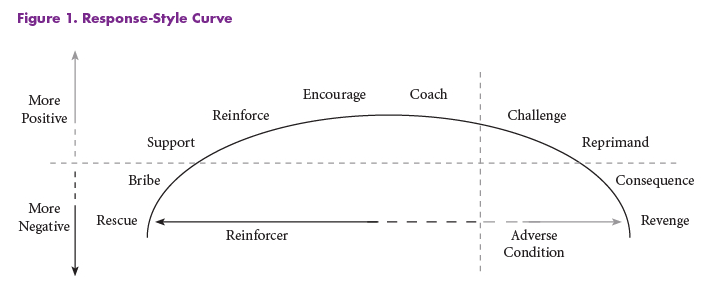This summer at camp you are bound to encounter some behaviors that are inappropriate. The types of possible behaviors are too numerous to list. As frontline staff, having a range of strategies to respond to these varying behaviors immediately will be critical to your success. The ten response types that make up the response-style curve provide a generalized set of options that can be used in any situation.
Ten Responses
The ten generalized responses are: rescue, bribe, support, reinforce, encourage, coach, challenge, reprimand, consequence, and revenge. These terms help guide what to try and are shown in the response-style curve in Figure 1 (see below). The selection and placement of the types of responses in the diagram reflects how we deal with behavior based on a behavioral psychology perspective. What this means in practice is each response has been placed on the curved continuum to help show four factors, positive versus negative approaches and encouraging versus discouraging behaviors.
Positive Responses
Using positive styles — support, reinforce, encourage, coach, challenge, and reprimand — has less chance of creating complications through generating adverse reactions and other behavior problems. For example, the use of bribes can create an ongoing expectation and so create constant demands and conflict over what will be the next reward.
To encourage a behavior you want, it helps to reward people in some way when they complete that behavior. Giving the reward should occur during or straight after the behavior to get maximum effect. This is the Premack Principle, named after the psychologist who developed reinforcement theory and is a well-established principle in behavioral psychology (Ramachandran, 2012, p. 750). The reward does not have to be anything tangible and can be things like giving a compliment, recognizing they completed the behavior, or thanking them. Or it could be that you allow them to do an activity they really wanted or enjoy doing.
Reeve in 1992 stated, “If there is one conclusion that is firm . . . a positive, rewarding approach is more effective than a negative, punishing approach” (p. 136). That conclusion continues to stand the test of time. Bloomquist and Schnell’s review of best practices supported the use of positive attention and reinforcement (2005, p. 173) and positive climate and behavior strategies (p. 257). This is why it is important to use the positive response types as often as we can.
Support
Support refers to working alongside and providing assistance. You help the camper complete the task but he or she still contributes. Example: “Okay, let’s get this place cleaned up. I will help you do it, and we will have it done in no time.”
Reinforce
The use of a reward encourages the behavior once a task has started or is completed. It can be provided without people expecting it after showing their own internal motivation to get the task done. The reward might be known at the outset but not to the extent that you are bribing them to comply. An example of this is once your campers have cleaned up the bunk they can then do more interesting and fun activities. This is using positive reinforcement (the Premack Principle) by following the required behavior with something that they would prefer to do. Example: “Thanks everyone for getting the campfire area tidied up today. I think you have all earned a treat.”
Encourage
This is reinforcing appropriate behavior through providing encouragement. It can occur before, during, and/or after the behavior. Example: Before — “Everyone is doing so well at keeping the camp clean of trash.” During/after — “Well done! Thanks for remembering to put your trash in the bin.”
Coach
As the word suggests, this is supporting by providing one-to-one feedback. It might take place away from others so it remains private. In a coaching style, you demonstrate required tasks, make suggestions, provide advice, discuss areas of improvement, monitor ongoing progress, promote reflection, and encourage or motivate when performance is not satisfactory. Example: “Why might it be hard to remember to put the trash in the garbage can?”
Challenge
Challenging is drawing attention to and promoting reflection on inappropriate behaviors. Asking, “Do you think your behavior is fair?” is presenting a challenge. If you are careful about your body language and tone of voice, you can ideally facilitate a discussion so that the camper reaches the appropriate conclusion about his or her behavior. Your interpretation or value judgment may still be provided after they have had time to reflect. Example: “Do you think leaving trash everywhere is respectful of the environment and other campers?”
Reprimand
Reprimand means that you judge a behavior to be inappropriate and unacceptable and immediately provide feedback. “That is not OK” or “That is unfair” are examples of reprimands. A value judgment is placed on the behavior with the demand that the behavior must change. Example: “Dropping trash on the ground is not okay!”
Negative Responses
Negative responses include rescue, bribe, consequence, and revenge. It is unrealistic to think that we can function without having consequences, as at times they are warranted and they can help create behavior change. But as there are many situations in which the more positive alternatives will work better, ideally you want to use consequences as infrequently as possible.
Baldwin and Baldwin, (1998, pp. 320-323) give a number of the reasons why using some type of punishment can get in the way of changing behavior for the better. Three of these are:
- Punishment usually causes increased intensity of responses. The emotional and physical response to punishment is greater than that of other approaches.
- Punishment tends to produce only temporary results. While the behavior is often suppressed initially, it generally recurs and requires ongoing monitoring and frequent, subsequent punishment. So it makes more sense to aim for a more permanent solution.
- People learn to avoid punishment and the people who use punishment. Therefore, punishment provides an incentive and can reinforce skills that help with avoiding punishment, like learning to tell better lies. They also try and avoid the people who use punishment. This leads to lost opportunities to control the undesirable behavior and/or teach desirable alternatives.
Consequence
When we use consequences sparingly and only when needed, they become a far more effective tool. Providing a consequence that the camper would want to avoid works best if the consequence is logical and directly related to the type of behavior you want to change. If the camper is constantly talking to friends in the safety briefing, moving him or her away from the friends is a logical consequence. Consequences can include loss of privileges, doing extra work, or time out. Of course, consequences should never involve physical punishment. Example: “Throwing trash on the ground is not respectful of our environment. I want you to pick it up, as well as that other bit over there, and put it all in the garbage can. If you continue to drop trash you will come back during the lunch break and clean up another area.”
Rescue
Rescue is intervening to solve the issue in instances when the person involved does not take responsibility for his or her behavior or solving the issue. The camper is rescued from the situation without any effort on his or her part. Example: You pick up all the trash being dropped without saying anything.
Bribe
This is the blatant use of a valued reward to obtain the desired behavior. The bribe is used as a payment for cooperation rather than a reward after completion. This helps to motivate the camper, but he or she is externally motivated solely by obtaining the reward. Because the expectation of the reward is prominent before and during the behavior, it becomes the only reason the camper complies. Example: “Whoever picks up the rubbish can get a special treat after dinner.”
Revenge
A negative action in retaliation for bad behavior that is emotionally charged and motivated often does not teach a valuable lesson. Rather than just a logical consequence of the behavior, this is usually a harsh punishment. Example: “I have had enough of trash being left everywhere. No one is going to get any marshmallows tonight.”
Helpful Guidelines When Responding to Inappropriate Behavior
|
References
Baldwin, J. D, and Baldwin, J. I. (1998). Behavior principles in everyday life, 3rd ed. Upper Saddle River, NJ: Prentice-Hall.
Bloomquist, M. L. and Schnell, S. V. (2005). Helping children with aggression and conduct problems: Best practices for intervention. New York, NY: Guildford Press.
Ramachandran, V. S. (2012). Encyclopedia of human behavior, 2nd ed. Saint Louis, MO: Academic Press.
Reeve, J. (1992). Understanding motivation and emotion. University of Rochester, River Campus: Harcourt Brace College Publishers.
Murray Irwin is an Australian-based freelance outdoor educator and adventure therapy group-leader with fourteen years’ experience. Currently he divides his time coordinating adventure and respite programs for people living with a mental illness, providing training services, and writing. He is the author of Encouraging Appropriate Behaviour: A Six-Step Approach and Intervening in Bullying Behaviour: Nine Ways to Take Direct Action. Visit www.encouraging-appropriate-behaviour.com.
Originally published in the 2014 May/June Camping Magazine.
Photo courtesy of Cheley Colorado Camps, Estes Park, Colorado



